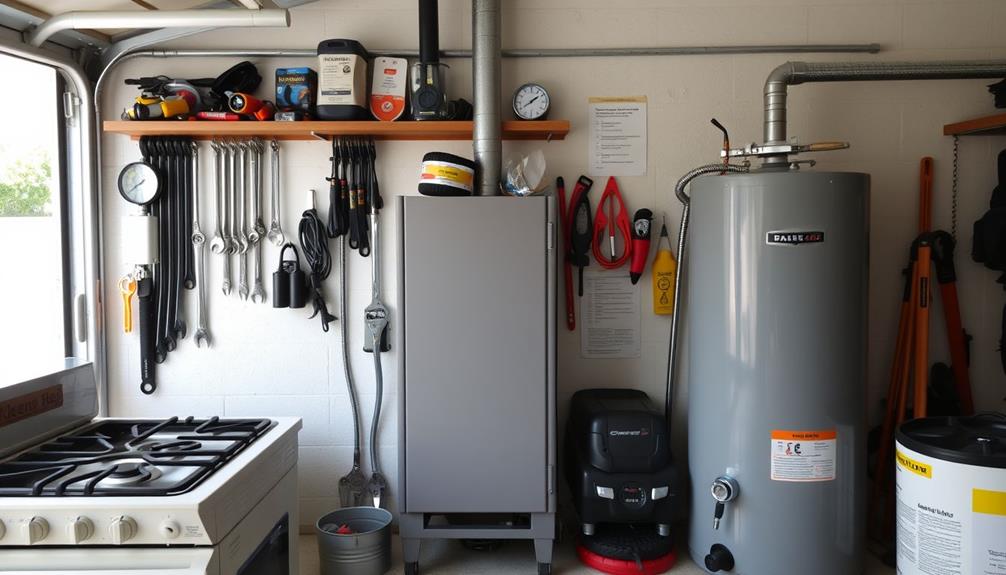Front-load washers use less water because they tumble clothes through a small, controlled amount of water, unlike top-load models that fill the entire drum. Their horizontal drum design and load sensors guarantee only the necessary water is used, which saves both water and energy. By optimizing water use based on load size and fabric type, front-load washers are more efficient. Want to discover more about how their design helps conserve resources? Keep exploring for detailed insights.
Key Takeaways
- Front-load washers tumble clothes through a small amount of water, reducing overall water usage compared to traditional models.
- They utilize precise load sensors to automatically adjust water levels based on load size and fabric type.
- Horizontal drum design promotes efficient water circulation and even cleaning with less water.
- Advanced technology and optimized drum design prevent overfilling and water spillage.
- Reduced water volume leads to less energy needed for heating and shorter drying times, enhancing efficiency.
The Mechanics of Washing: Tumbling vs. Agitation
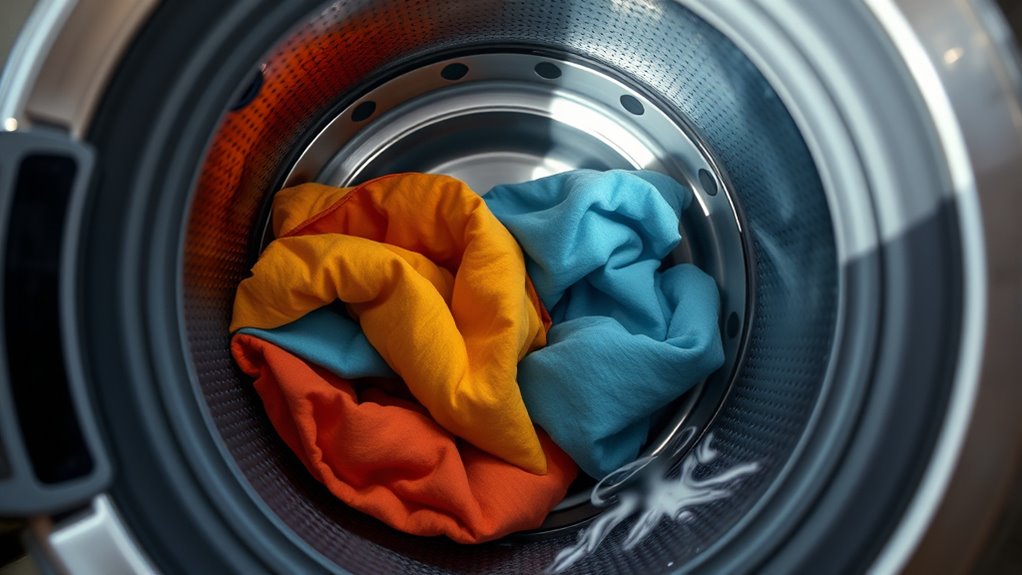
Although both tumbling and agitation are common washing methods, they operate very differently to clean your clothes. Tumbling, used in front-load washers, rotates the drum on a horizontal axis, flipping clothes through water and detergent. This gentle, continuous motion allows water and soap to reach every fabric surface efficiently. In contrast, agitation, typical in top-load washers, uses a central agitator that moves clothes up and down vigorously, creating more water turbulence. While agitation can be effective at removing dirt, it often requires more water to fully submerge garments and maintain consistent cleaning. Tumbling’s controlled motion minimizes water use because it relies on gravity and rotation rather than constant agitation. This difference in mechanics directly impacts water consumption, making tumbling more water-efficient. Additionally, the design of water displacement in tumbling washers ensures effective cleaning with less water, highlighting the importance of energy-efficient operation in modern washing machines. Recognizing the washing cycle and how it interacts with water usage underscores why front-load washers are a more sustainable choice.
Water Usage in Traditional Top-Load Washers

Traditional top-load washers fill the entire tub with water for each cycle, regardless of load size. This means you’re using more water than necessary, even for smaller loads. Continuous water circulation guarantees clothes are thoroughly rinsed but also increases overall water consumption. To address this inefficiency, modern washers incorporate data-driven strategies that optimize water use based on load size and type. These systems often utilize smart sensors to detect load weight and fabric type, adjusting water levels accordingly. These smart systems leverage AI entertainment technologies to adapt washing patterns, further reducing water waste and enhancing efficiency.
Full Tub Filling
Full tub filling is a hallmark of conventional top-load washers, where the drum is completely submerged in water during each cycle. You fill the entire drum with water, regardless of how much laundry you’re washing. This means you often use more water than necessary, especially when washing small loads. The design aims to guarantee clothes are fully immersed and agitated thoroughly, but it results in higher water consumption overall. You might notice that even lightly soiled or small loads still require filling the entire tub. This approach leads to inefficiency, as water is wasted when full capacity isn’t needed. While it guarantees thorough cleaning, it’s also a major reason why traditional top-load washers use more water compared to newer, more efficient models. Additionally, full tub filling can contribute to increased energy usage due to the need to heat and move larger volumes of water. Embracing water-saving innovations can significantly reduce this impact while maintaining cleaning performance.
Continuous Water Circulation
Have you ever wondered how top-load washers keep clothes moving during a cycle? They use continuous water circulation, where water constantly flows through the drum, soaking the clothes evenly. This ongoing movement helps loosen dirt and distribute detergent effectively. Unlike front-load washers, which use less water and rely on tumbling, traditional top-loads cycle water in and out, creating a steady flow. This process keeps clothes submerged and moving, but it also wastes a lot of water since the tub remains filled throughout most of the cycle. The constant circulation means more water is needed to keep everything evenly wet and moving. As a result, top-load washers typically use more water than front-load models that utilize less water and energy through more efficient designs. Additionally, the water usage in traditional top-load washers is higher because of this continuous flow process, which is a characteristic of their water circulation method. The design of these washers often results in higher water consumption compared to other models that utilize energy-efficient techniques.
How Front-Load Washers Optimize Water Efficiency

Front-load washers are designed to use markedly less water than other types of washing machines by leveraging their unique horizontal drum orientation. This design allows you to load clothes more efficiently, ensuring that water fully covers the items without excess. Unlike top-loaders that fill the drum and leave some clothes partially exposed, front-loaders tumble clothing through a small amount of water, reducing overall water use. They also use low water levels optimized for each load size, preventing unnecessary fill. Sensors detect load weight and fabric type, adjusting water levels automatically. This precise control minimizes waste and ensures thorough cleaning with less water. By focusing water only where needed, front-load washers substantially enhance water efficiency, saving you both water and energy. Additionally, understanding water-saving techniques can further improve overall efficiency and environmental impact. Many modern washers incorporate sensor technology that automatically adjusts water levels, making it easier to optimize water use without manual intervention. Moreover, advances in machine design contribute to even greater water conservation.
The Role of Drum Design in Water Conservation

Your washer’s drum design plays a key role in conserving water. A vertical alignment promotes efficient water circulation and reduces overfilling risks. This thoughtful engineering helps you use less water while still getting your clothes clean. Additionally, innovative drum features can further optimize water usage during each cycle. Proper cultural heritage considerations in design also influence how effectively water is used, ensuring both efficiency and sustainability.
Vertical Drum Alignment
Vertical drum alignment plays an essential role in optimizing water efficiency within front-load washers. When the drum is properly aligned, it spins smoothly, reducing vibrations and preventing water leaks. Misalignment can cause uneven water distribution, leading to excessive water use to guarantee thorough cleaning. A well-aligned drum maintains consistent contact with clothes, improving washing performance while using less water. Precise alignment also minimizes mechanical stress, extending the washer’s lifespan and maintaining efficiency over time. Advanced sensors and calibration features in modern washers help you achieve perfect drum alignment during setup, ensuring ideal water use. By paying attention to vertical alignment, you ensure your front-load washer operates as efficiently as possible, saving water and energy while delivering effective cleaning.
Efficient Water Circulation
The design of the drum plays a crucial role in guaranteeing efficient water circulation during the wash cycle. A well-designed drum helps water reach all areas of your laundry, reducing waste and improving cleaning. Front-load washers often feature a horizontal drum with a gentle incline, which promotes better water flow and tumbling action. This design minimizes water usage while maximizing cleaning power. To optimize water circulation, consider these features:
- Agitation patterns that create even water distribution.
- Vortex channels that direct water flow efficiently.
- Strategic drum perforations to allow water to reach every fabric part.
- Inclined drum design to facilitate thorough water contact and movement.
These elements work together to ensure your laundry gets clean with less water, making your washer more efficient.
Reduced Overfilling Risk
A well-designed drum not only improves water circulation but also helps prevent overfilling during cycles. Front-load washers typically feature a conical or tapered drum, which limits the maximum water level, reducing the risk of overfilling. This design ensures you don’t waste water or cause leaks. The drum’s shape guides water flow efficiently, making it easier to control water levels precisely. Here’s a quick comparison:
| Feature | Top-Load Washers | Front-Load Washers | Benefit |
|---|---|---|---|
| Drum Shape | Cylindrical | Conical/Tapered | Limits overfilling |
| Water Level Control | Manual/Automatic | Precise sensors | Prevents excess water use |
| Overflow Prevention | Less effective | Highly effective | Reduces spillage and waste |
This design plays a key role in conserving water and maintaining safe operation.
Load Size and Water Consumption
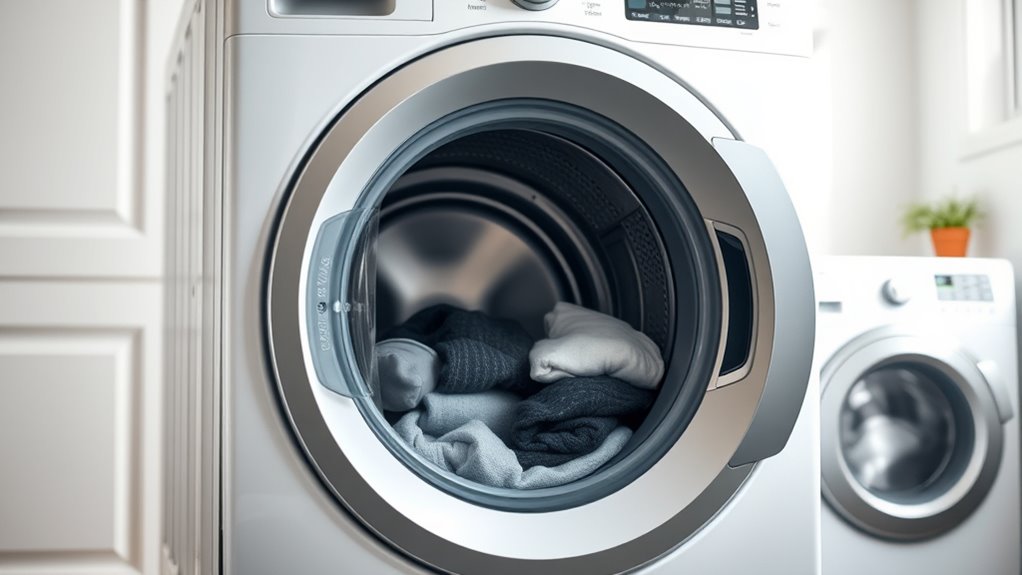
Since front-load washers are designed to be more efficient, their water usage directly depends on the load size you select. When you load the machine, the washer adjusts water levels based on the weight and volume of your laundry. This means smaller loads use less water, saving resources. To maximize water efficiency, keep in mind:
- Always load the washer to its recommended capacity.
- Avoid overloading, which can increase water use and reduce cleaning effectiveness.
- Use the appropriate cycle settings for different load sizes.
- Regularly clean the lint filter to maintain optimal water flow.
Energy Efficiency and Water Savings
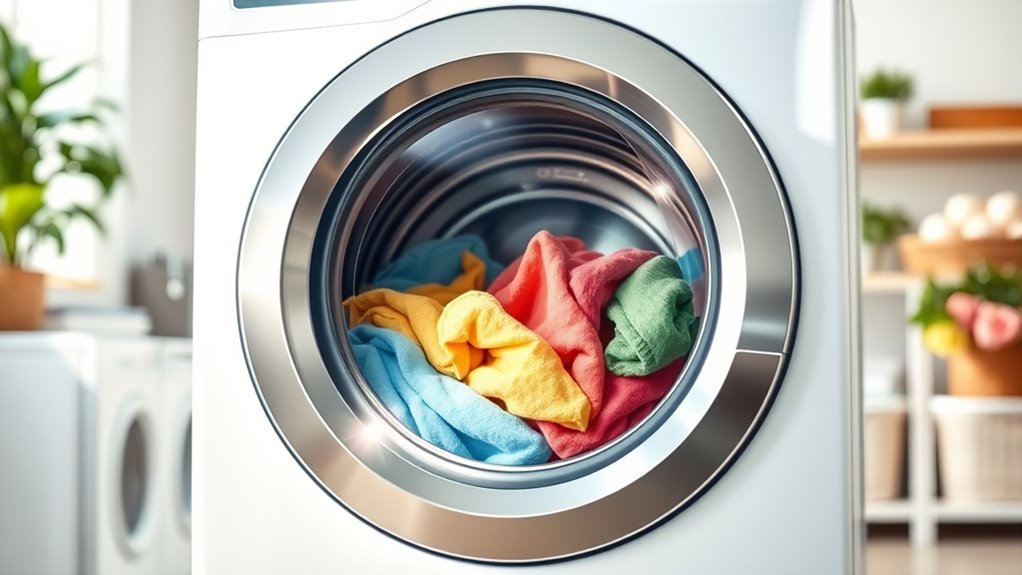
Opting for a front-load washer can substantially boost your home’s energy efficiency and water savings. These washers use less water per load because they don’t fill the drum completely, unlike traditional top-loaders. Since they require less water, they also consume less energy to heat that water, reducing your electricity bills. Additionally, front-load washers spin faster, extracting more water from your clothes, which shortens drying time and saves energy in your dryer. Their advanced design guarantees each wash uses only the necessary amount of water, making them more efficient overall. By choosing a front-load washer, you not only cut water usage but also lower your energy consumption, benefiting your household budget and the environment.
Smart Technology and Water Management

Smart technology in modern front-load washers allows you to monitor and control water usage more effectively. With built-in sensors and smart features, you can customize wash cycles based on load size and fabric type, ensuring no water is wasted. Here are four ways this technology helps you manage water better:
- Load detection sensors automatically adjust water levels for each load.
- Cycle optimization selects the perfect amount of water based on fabric and soil level.
- Remote monitoring lets you control and track water use via smartphone apps.
- Automatic water shut-off stops water flow once the cycle completes, preventing waste.
Environmental Benefits of Using Less Water
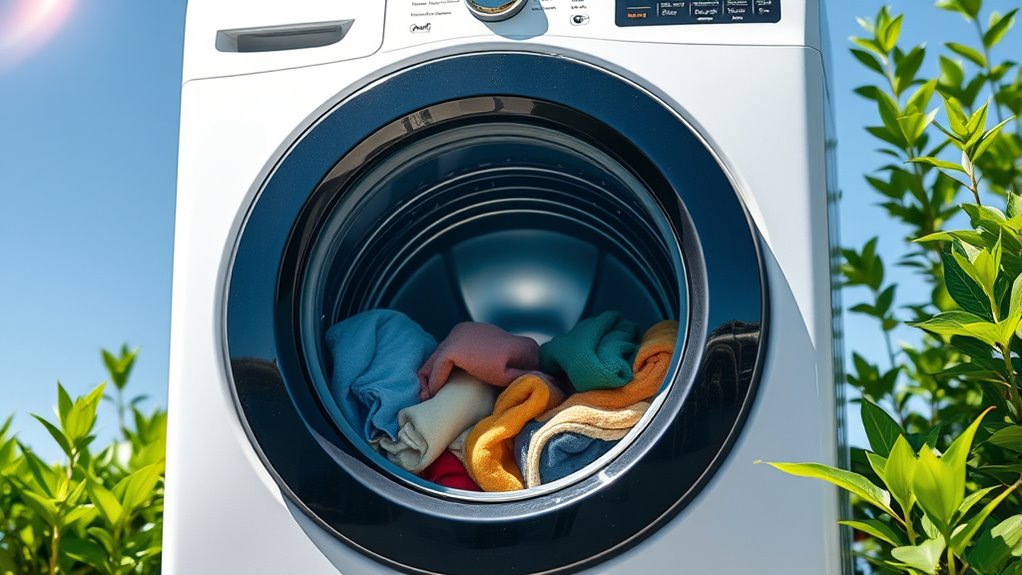
Using less water with your front-load washer not only saves you money on utility bills but also contributes considerably to protecting the environment. When you reduce water use, you lower the strain on local water sources, helping preserve ecosystems and wildlife. Less water consumption also means less energy needed for heating and pumping, decreasing your carbon footprint.
| Water Saved | Environmental Impact |
|---|---|
| 30 gallons per load | Preserves freshwater supplies |
| Reduced energy use | Cuts greenhouse gas emissions |
| Less wastewater | Protects rivers and oceans |
Tips for Maximizing Water Efficiency With Your Washer
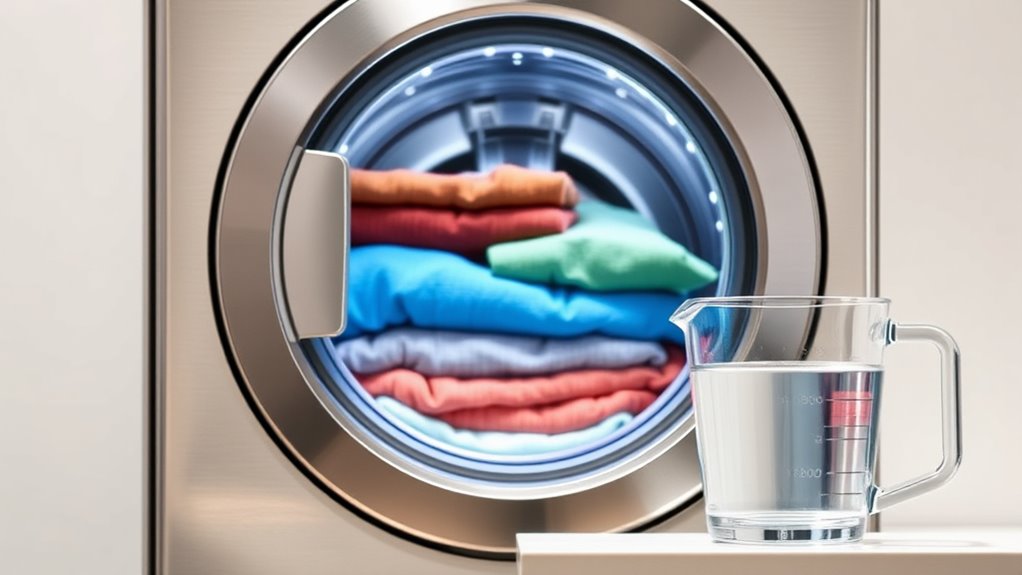
To maximize water efficiency with your front-load washer, start by selecting the appropriate load size for each wash cycle. Overloading or underloading wastes water and reduces cleaning effectiveness. Next, always choose eco-friendly or water-saving settings when available. Using cold water instead of hot can also cut water and energy use. Additionally, regularly clean the washer’s filters and door seals to prevent drainage issues. Finally, run full loads whenever possible to make the most of each wash cycle.
Here are some tips to help you save water:
- Use the correct load size setting for each wash.
- Select eco-friendly or water-saving wash cycles.
- Wash full loads to maximize efficiency.
- Keep your washer clean and well-maintained.
Frequently Asked Questions
Do Front-Load Washers Require Special Detergent Types?
You might wonder if front-load washers need special detergents. They actually do work best with high-efficiency (HE) detergents, which are formulated to produce fewer suds. Using regular detergent can cause excess sudsing and affect performance. HE detergents are designed to clean effectively with less water, helping your washer run smoothly and last longer. So, stick with HE detergent for supreme cleaning and to protect your machine.
How Does Water Temperature Affect Efficiency?
You might think hot water cleans better, but using the right temperature actually boosts efficiency. Cold water saves energy and is gentler on fabrics, reducing wear and tear. Warm water dissolves detergents more effectively, cleaning stains better without wasting excess energy. Hot water, while powerful, consumes more energy and isn’t always necessary. Adjust the temperature based on your laundry needs to optimize cleaning and save resources.
Are Front-Load Washers Suitable for Large Families?
Front-load washers are great for large families because they handle bigger loads efficiently and save water. You’ll appreciate their capacity to wash more clothes at once, reducing the number of cycles needed. Plus, they typically use less water and energy, helping you save on bills. If you often do laundry for many people, a front-load washer is a smart choice, making your chores easier and more economical.
Can I Retrofit My Old Washer to Save Water?
So, you want to retrofit your old washer to save water? That’s like putting a tiny bandage on a leaky faucet—possible, but not really effective. Instead, you should consider upgrading to a modern, water-efficient front-load washer. It’s designed to use less water and energy, saving you money in the long run. Plus, you get the satisfaction of knowing you’re doing your part for the planet—no duct tape needed!
How Long Do Front-Load Washers Typically Last?
Front-load washers usually last about 10 to 15 years if you take good care of them. You might notice some wear and tear after several years, but regular maintenance can extend their lifespan. Keep the door seal clean, avoid overloading, and run occasional cleaning cycles. With proper care, your front-loader can serve you well for a decade or more, making it a reliable choice for your laundry needs.
Conclusion
Just like a skilled chef carefully measures ingredients, choosing a front-load washer helps you use water wisely. By understanding how these machines operate and optimizing your load sizes, you can save water and energy effortlessly. Embrace these smart choices, and you’ll see your water bills shrink while doing your part for the environment. Switching to a front-loader is like turning on a gentle rain instead of a storm—quiet, efficient, and beneficial for all.



